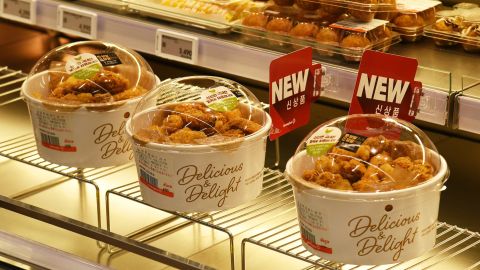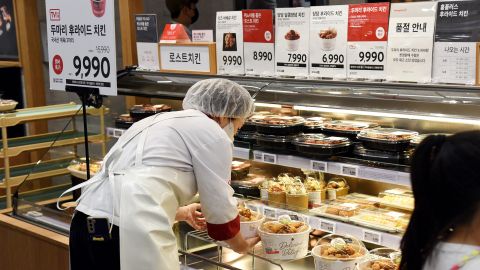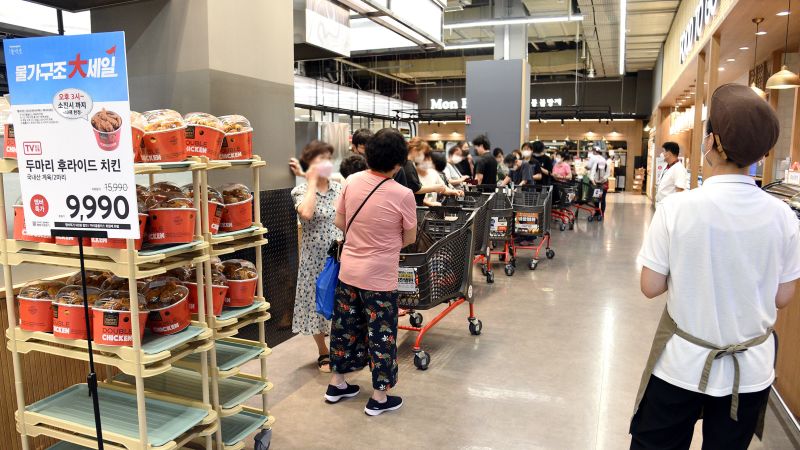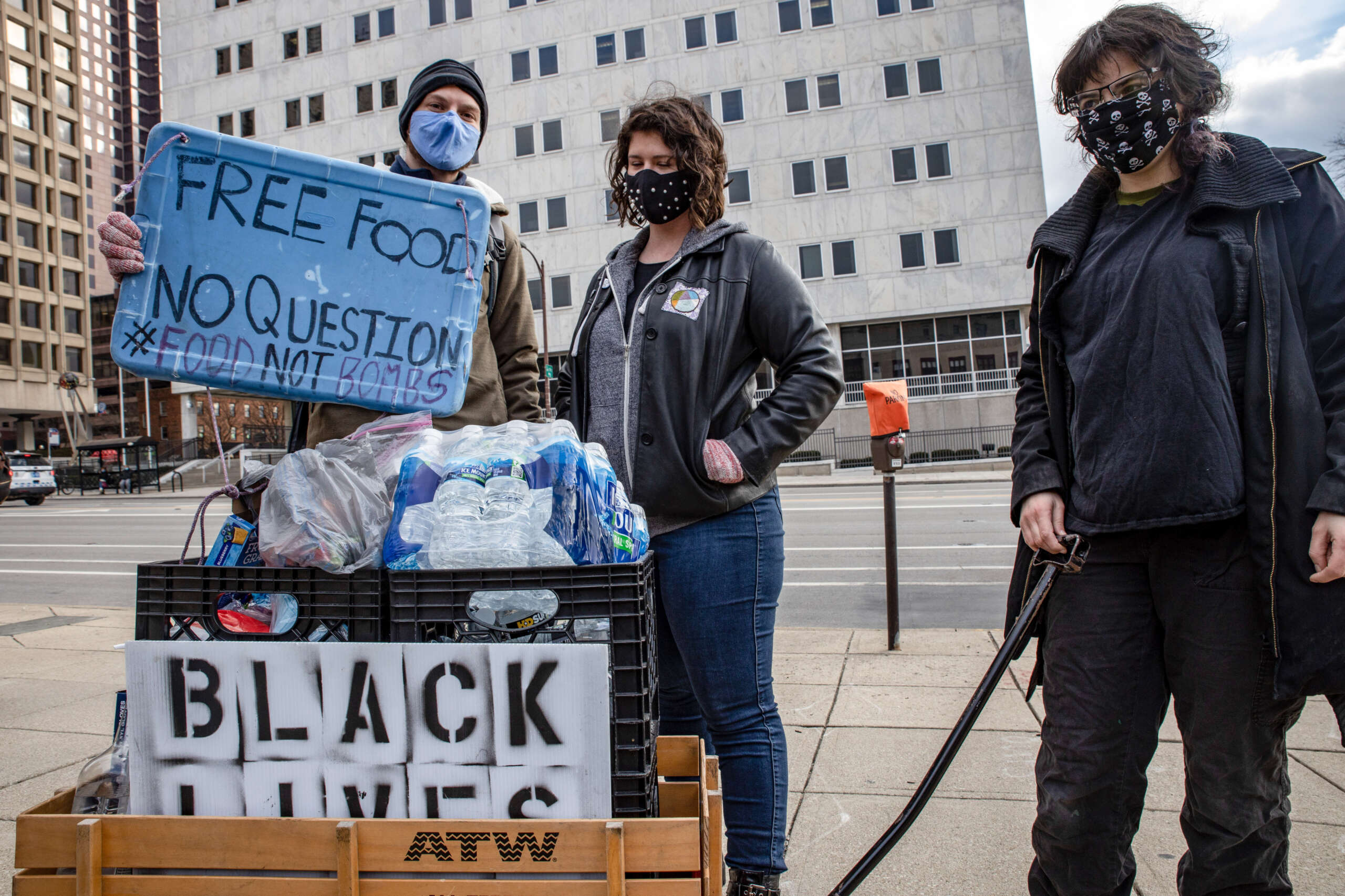Hong Kong/Seoul
CNN Business
—
Clark Park, a 35-year-old YouTuber, is one of many people in South Korea fed up with high food prices.
That’s why he grabbed his camera and joined a huge throng of shoppers clamoring for cheap fried chicken one August morning at Homeplus, a hypermarket chain that had just slashed 12% off its already-heavily discounted prices.
“There were already over 50 people lined up,” Park told CNN Business, adding that many arrived early and waited well over an hour. “We all ran together to the deli as soon as it opened. That’s when I felt the craze of fried chicken.”
Fried chicken has long been a favorite of consumers in South Korea — and now it also underscores the country’s inflationary woes, with food prices across the board weighing more on wallets lately.
The average cost of fried chicken in South Korea was up 11.4% in August compared to the same month a year ago, outpacing price jumps of other popular dining items such as kimchi stew or beef barbecue, according to government data.
Consumers might be feeling an even bigger pinch, depending on how much restaurants or supermarkets pass on their costs: In some cases, retail chicken prices have “gone up by more than 50%” over the past two years, according to Jeong Woo Park, a South Korea economist at Nomura.
People around the world have been dealing with similar struggles in recent months as global food prices soared — and scenes like the chicken run at Homeplus are a reminder of how households are adjusting to broader inflation, which has hit 5.7% in South Korea. They also spotlight how the country relies on other nations for much of its food.
Fried chicken is a huge cultural touchpoint in South Korea, similar to British fish and chips, which have also gotten more expensive this year. Many people see it as a must-have snack at sporting events, and it’s not uncommon for customers to pick it up several times a month.
Anyone visiting the country is bound to stumble on a local chicken and beer, or “chimac,” joint. That’s because one in every 20 restaurants is a chicken eatery, according to the government.
South Korea is the world’s third largest market for fried chicken, outpaced only by the far more populous United States and China, data from market research provider Euromonitor International shows.
Crispy chicken “can be called a national food in South Korea, such as kimchi, bulgogi, and bibimbap,” said Clark Park, the content creator, referring to other staples that locals cherish.
Like other cultural-favorite dishes, it’s also serious business: Korean chicken restaurants booked $7.9 billion in revenue in 2021, according to Euromonitor.

This kind of devotion has created a conundrum for stores, which must take care of their bottom lines without alienating customers.
“All costs related to fried chicken are rising very fast,” said Jeong Woo Park, the Nomura economist, adding that vendors are being hit by soaring costs of oil, rent, labor, delivery services and even chicken feed. In response, he added, some restaurants have started using robots to bring labor costs down.
Sellers have taken vastly different approaches to the situation in recent months. Leading chicken chains have raised menu prices by an average of 2,000 Korean won ($1.50), according to Yunjin Park, a senior research analyst of food and nutrition at Euromonitor, citing the “rising prices of ingredients.” This led to a roughly 10% to 15% jump in the price of fried chicken, she added.
While the difference may seem small, it could easily mean customers will have to fork out nearly $22 for a simple meal, Yunjin Park told CNN Business: “Chicken, which used to be comfort food for Koreans, is now no longer an easy-to-order menu [item] without hesitation.”
By contrast, local hypermarkets are going in the other direction. The August sale that Clark Park attended at Homeplus was for what the chain called “dangdang chicken,” a promotion of fried chicken for about a third of the price most retailers offer.
Other stores are feeling pressured to follow suit, albeit only for short periods. In August, emart, another major supermarket chain, launched a one-week promotion to sell fried chicken at almost 50% off — and sold all 60,000 pieces.
Not everyone can afford to slash prices, though, and some smaller outlets could be forced to close until their costs come down again.

“If you look at how those chain businesses are able to sell at these low rates, that’s basically due to economies of scale,” said Barsali Bhattacharyya, manager of industry briefing at the Economist Intelligence Unit (EIU).
“They’re able to buy more products and consequently ask for a better rate from their suppliers. Now, your small mom-and-pop stores are not going to be able to enjoy that advantage, which means they are looking at their costs going much higher.”
One reason South Korea is facing such problems is that it imports almost half of its food, according to the EIU.
It’s one of the Asian economies most exposed to surging prices around the world, because it depends on other countries for many types of food, Nomura economists warned in a June report. Singapore, Hong Kong and the Philippines are also seen as vulnerable.
Global food prices have soared this year, largely because of Russia’s invasion of Ukraine. Both countries are typically major exporters of essential goods like wheat and sunflower oil.
The worst may already be over: In August, the United Nations’ Food Price Index fell for the fifth straight month, and in Korea, overall inflation also eased more than projected.
But things aren’t expected to improve significantly anytime soon. “We think inflation has now passed its peak, but it will likely remain above 5% for the rest of the year,” Min Joo Kang, ING’s senior economist for South Korea and Japan, wrote in a note to clients.
Other pantry staples are getting more expensive elsewhere in Asia, too.
Last month, Thailand — where the government sets pricing on some food staples — raised prices on instant noodles for the first time in 14 years. A packet from a popular brand there has increased the equivalent of 3 to 20 cents, threatening to disproportionately hurt low-income families.
“Food inflation is a sticky issue for Asia,” said Bhattacharyya.
Because incomes in most of the region fall in the low or middle range, food usually makes up a big share of total consumer spending — in some cases, reaching 30% to 40%, she said.
She concluded: “It was, I think, a matter of time before the global food price crisis hit Asia.”
-— CNN’s Gawon Bae in Seoul and Kocha Olarn in Bangkok contributed to this report.






More Stories
Essential Kitchen Tools Every Home Chef Needs
West Palm Beach front Activists Deal with Fees for Sharing Food stuff With Unhoused Community
Nutritional psychiatry professor Felice Jacka: ‘The global food stuff process is the primary bring about of early death’ | Foodstuff